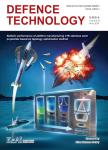Laser cut hole matrices in novel armour plate steel for appliqué battlefield vehicle protection
Laser cut hole matrices in novel armour plate steel for appliqué battlefield vehicle protection作者机构:Engineering Manufacturing Centre College of Engineering Swansea University Swansea UK
出 版 物:《Defence Technology(防务技术)》 (Defence Technology)
年 卷 期:2016年第12卷第5期
页 面:351-359页
核心收录:
学科分类:08[工学] 0806[工学-冶金工程] 0817[工学-化学工程与技术] 0826[工学-兵器科学与技术] 0805[工学-材料科学与工程(可授工学、理学学位)] 0802[工学-机械工程] 0703[理学-化学] 0701[理学-数学] 0801[工学-力学(可授工学、理学学位)] 0702[理学-物理学]
基 金:the support of Swansea University during the pursuit of this research
主 题:Armour steels Defence systems Steel processing Armour engineering
摘 要:During this research, experimental rolled homogeneous armour steel was cast, annealed and laser cut to form an appliqué plate. This Martensitic–Bainitic microstructure steel grade was used to test a novel means of engineering lightweight armour. It was determined that a laser cutting speed of 1200 mm/min produced optimum hole formations with limited distortion. The array of holes acts as a double-edged solution, in that they provide weight saving of 45%, providing a protective advantage and increasing the surface area. Data collected were used to generate laser cut-edge hole projections in order to identify the optimum cutting speed, edge condition, cost and deformation performance. These parameters resulted in the generation of a surface, with less stress raising features. This can result in a distribution of stress across the wider surface. Provided that appropriate process parameters are used to generate laser cut edges, then the hardness properties of the surface can be controlled. This is due to compressive residual stresses produced in the near edge region as a result of metallurgical transformations. This way the traverse cutting speed parameter can be adjusted to alter critical surface characteristics and microstructural properties in close proximity to the cut-edge. A relationship was identified between the width of the laser HAZ and the hardness of the cut edge. It is the thickness of the HAZ that is affected by the laser process parameters which can be manipulated with adjusting the traverse cutting speed.



